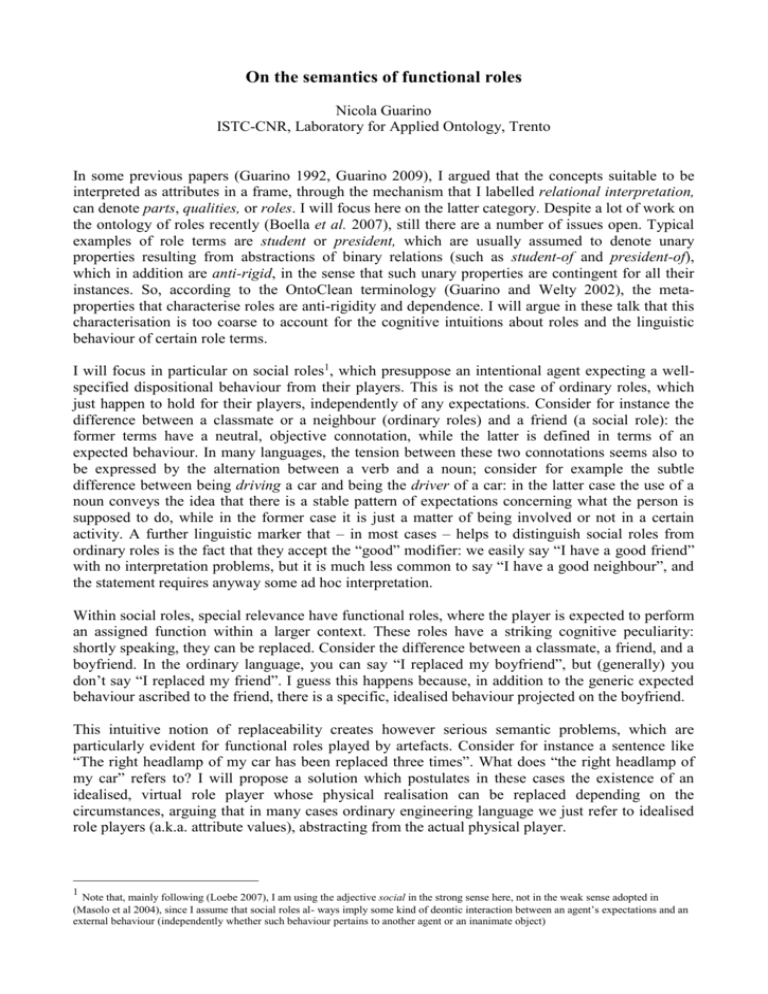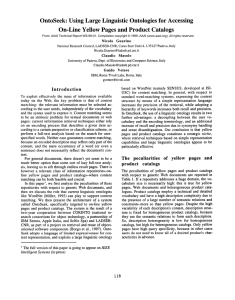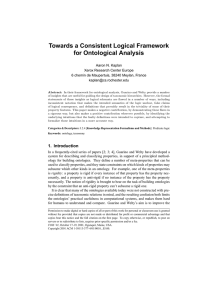Continued
advertisement

On the semantics of functional roles Nicola Guarino ISTC-CNR, Laboratory for Applied Ontology, Trento In some previous papers (Guarino 1992, Guarino 2009), I argued that the concepts suitable to be interpreted as attributes in a frame, through the mechanism that I labelled relational interpretation, can denote parts, qualities, or roles. I will focus here on the latter category. Despite a lot of work on the ontology of roles recently (Boella et al. 2007), still there are a number of issues open. Typical examples of role terms are student or president, which are usually assumed to denote unary properties resulting from abstractions of binary relations (such as student-of and president-of), which in addition are anti-rigid, in the sense that such unary properties are contingent for all their instances. So, according to the OntoClean terminology (Guarino and Welty 2002), the metaproperties that characterise roles are anti-rigidity and dependence. I will argue in these talk that this characterisation is too coarse to account for the cognitive intuitions about roles and the linguistic behaviour of certain role terms. I will focus in particular on social roles1, which presuppose an intentional agent expecting a wellspecified dispositional behaviour from their players. This is not the case of ordinary roles, which just happen to hold for their players, independently of any expectations. Consider for instance the difference between a classmate or a neighbour (ordinary roles) and a friend (a social role): the former terms have a neutral, objective connotation, while the latter is defined in terms of an expected behaviour. In many languages, the tension between these two connotations seems also to be expressed by the alternation between a verb and a noun; consider for example the subtle difference between being driving a car and being the driver of a car: in the latter case the use of a noun conveys the idea that there is a stable pattern of expectations concerning what the person is supposed to do, while in the former case it is just a matter of being involved or not in a certain activity. A further linguistic marker that – in most cases – helps to distinguish social roles from ordinary roles is the fact that they accept the “good” modifier: we easily say “I have a good friend” with no interpretation problems, but it is much less common to say “I have a good neighbour”, and the statement requires anyway some ad hoc interpretation. Within social roles, special relevance have functional roles, where the player is expected to perform an assigned function within a larger context. These roles have a striking cognitive peculiarity: shortly speaking, they can be replaced. Consider the difference between a classmate, a friend, and a boyfriend. In the ordinary language, you can say “I replaced my boyfriend”, but (generally) you don’t say “I replaced my friend”. I guess this happens because, in addition to the generic expected behaviour ascribed to the friend, there is a specific, idealised behaviour projected on the boyfriend. This intuitive notion of replaceability creates however serious semantic problems, which are particularly evident for functional roles played by artefacts. Consider for instance a sentence like “The right headlamp of my car has been replaced three times”. What does “the right headlamp of my car” refers to? I will propose a solution which postulates in these cases the existence of an idealised, virtual role player whose physical realisation can be replaced depending on the circumstances, arguing that in many cases ordinary engineering language we just refer to idealised role players (a.k.a. attribute values), abstracting from the actual physical player. 1 Note that, mainly following (Loebe 2007), I am using the adjective social in the strong sense here, not in the weak sense adopted in (Masolo et al 2004), since I assume that social roles al- ways imply some kind of deontic interaction between an agent’s expectations and an external behaviour (independently whether such behaviour pertains to another agent or an inanimate object) Boella G, van der Torre L, Verhagen H 2007. Roles, an interdisciplinary perspective. Applied Ontology 2(2):81–88. Guarino N. 1992. Concepts, Attributes, and Arbitrary Relations: Some Linguistic and Ontological Criteria for Structuring Knowledge Bases. In R.P. van de Riet and R.A. Meersman (eds.), Linguistic Instruments in Knowledge Engineering, Elsevier Science Publishers 1992:195-211 Guarino, N. 2009. The Ontological Level: Revisiting 30 Years of Knowledge Representation. In Alex Borgida, Vinay Chaudhri, Paolo Giorgini, Eric Yu (eds.), Conceptual Modelling: Foundations and Applications. Essays in Honor of John Mylopoulos, Springer Verlag 2009, pp. 52-67. Guarino, N. and Welty, C. 2009. An introduction to Ontoclean (revised version). In S. Staab and R. Studer (eds.), Handbook on Ontologies, Second Edition. International handbooks on information systems. Springer Verlag: 201-221. Loebe F. 2007. Abstract vs. social roles–Towards a general theoretical account of roles. Applied Ontology 2(2):127–158. Masolo, C., Vieu, L., Bottazzi, E., Catenacci, C., Ferrario, R., Gangemi, A., and Guarino, N. 2004. Social roles and their descriptions. In D. Dubois, C. Welty and M. Williams, editors, Proceedings of the 9th International Conference on the Principles of Knowledge Representation and Reasoning (KR), pp. 267–277.







